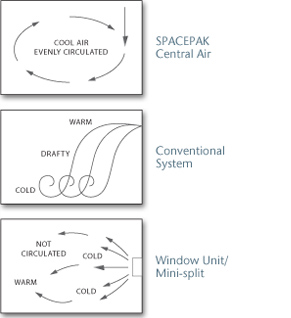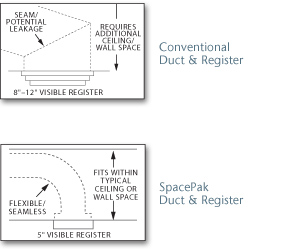Have you heard of high velocity air conditioning, but are unsure of what makes it different from other types of AC? You are not alone — this is a question we get a lot. As a local expert on the matter, Matt Borden has the information to make a somewhat complicated answer less so.
Circulation
The first major difference between high velocity and other types of cooling is how they work. All air conditioners are considered “forced air” units, but the different types rely on certain methods of air circulation.
Conventional AC systems rely on the method of diffusion, where cool air enters a room through a vent (supply vent), then is drawn back out through another vent (intake vent). Naturally, hot air rises and cold air sinks so the circulation in the room depends greatly on the placement of the supply and intake vents.
High velocity AC systems rely on the aspiration method, where air is delivered with such speed that it creates air currents which circulate the cooled air throughout the room. In addition to creating better circulation, high velocity air conditioning systems do a great job of reducing humidity.
Ducting
 With all central air conditioning, ducts are needed to carry the cool air throughout the building. However, certain properties are restricted when it comes to the type of ducting will fit with the architecture.
With all central air conditioning, ducts are needed to carry the cool air throughout the building. However, certain properties are restricted when it comes to the type of ducting will fit with the architecture.
Conventional AC systems require metal ductwork that averages about 6″ in diameter. This ductwork runs in two branches for the supply and intake of cool air. All of this ducting does require a significant amount of space. In many cases, some construction is needed to fit the building.
High velocity AC systems use smaller, insulated aluminum tubes for ducting. These tubes are flexible and average about 2″ in diameter. Because of the size, these tubes are generally easier to fit into existing walls, floor joists, etc. Many older homes are better candidates for high velocity AC.
Cost
This aspect is a little more complicated, and can vary greatly depending on the unique features of a property. There is significant cost associated with any type of retrofitting for these systems. However, the materials used in the high velocity air AC systems can cause the tubing to be more expensive than conventional AC systems. On the other hand, many high velocity installations end up being cheaper than traditional due to the lower construction costs.
If you have questions that still haven’t been answered, be sure to check out our High Velocity Air Conditioning page. Of course, we’re always happy to answer your questions as well. Fill out a form or call (610) 325-9966.




